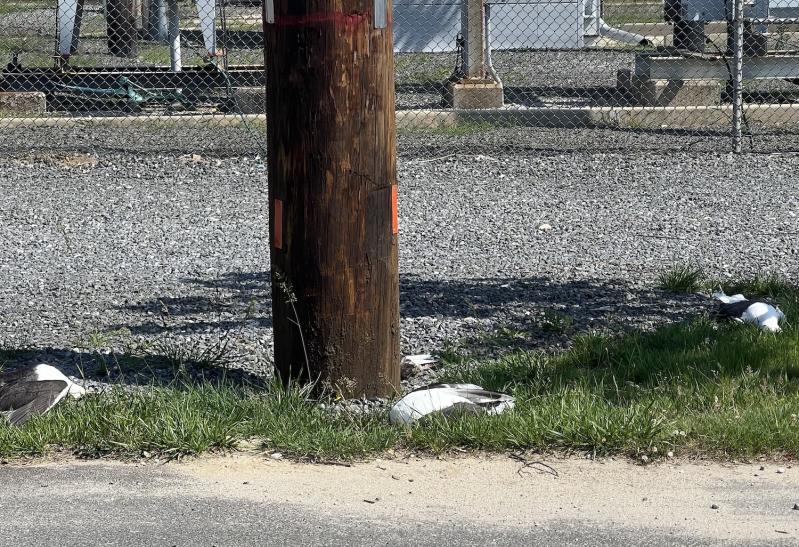Gwendolen Bokine first noticed the dead birds in late June, when she was out for her daily run. Two gulls at the base of an electrical pole near the PSEG electrical substation on Industrial Road in Montauk. Since then, she has found 11 more. Ms. Bokine expressed her concern to PSEG, but when she didn’t hear back, she contacted the New York State Department of Environmental Conservation, which collected a herring gull and a great black-backed gull from the location.
“This doesn’t have to happen,” said Ms. Bokine. “Something needs to be done.”
Last Thursday, the D.E.C. received the results of the necropsy and confirmed that one of those birds had died from electrocution.
“The great black-backed gull was decomposed so a determination on cause of death for that bird was not possible,” according to a statement from the D.E.C. “The herring gull had obvious but subtle burn trauma and internal hemorrhage consistent with electrocution.”
Sara Childs-Sanford, associate professor of wildlife medicine at the Janet L. Swanson Wildlife Hospital at Cornell University, said electrocution is not always obvious in birds. “It could just have minor singeing of feathers or burn marks on their feet. Burns could be anywhere on their body. They could catch fire, but it’s not always that obvious.”
She said just landing on a wire won’t electrocute a bird. It would need to create a circuit, by touching two electrified parts, so the electricity flows through them. For this reason, she said electrocution is more common in larger birds. “They may spread a foot or wing and make a connection between two parts of the system. This usually happens on a pole where there are conductors that can be touched at the same time. Most of the time, electrocuted birds are found directly beneath the pole,” she said.
Industrial Road, because of its geography and development, has long been a dangerous area for birds. It occupies a small strip of land between Fort Pond Bay and Fort Pond. Shai Mitra, an ornithologist at the College of Staten Island and editor of the New York State Ornithological Association quarterly The Kingbird, said “Gulls love Fort Pond because it’s fresh water and good for loafing, drinking, and bathing. They’ll come into it from the bay and from the ocean. Wherever you have a big freshwater pond close to an ocean and bay it’s going to be attractive to gulls.”
It’s not just gulls that are dying. Valinda Valcich, a volunteer rescuer with the Evelyn Alexander Wildlife Rescue Center in Hampton Bays, said she came across three dead ospreys as well. “A bird was holding two fish, one in each talon,” she said. “The osprey had no injuries at all. The wing was fine, the body was fine. It was right near the substation,” said Ms. Valcich.
Ms. Bokine said that in early July an osprey fell from the sky and landed just in front of her as she ran along Industrial Road. It was so stunned that she was able to approach it and shepherd it away from the road before it eventually flew off.
“A dead osprey with fish in its talons sounds like something happened very suddenly, and that leans towards the electrocution angle,” said Mr. Mitra. But what about dead swans? “A swan wouldn’t perch,” he said. Jim Grimes, an East Hampton Town Trustee and longtime resident of Montauk, said that when he was a kid, it was common to find dead swans in the area. “I don’t think they get electrocuted; they tend to break their wings on the wires.” Last year, Ms. Valcich found a dead swan along the road too.
Jim Hackett, who has worked at Montauk Manor for 29 years, and drives by the location daily, said he, too, started noticing the birds at the base of a utility pole in the last month.
“In the first two weeks of the month, I saw about 10 dead gulls right at the base of the same pole,” he said. “I felt bad. What the hell?” Apart from the dead birds, he saw another walking around the train tracks by Industrial Road, mouth open, gasping.
So, while some birds directly adjacent to the pole are getting electrocuted, something else seems to be affecting birds along the popular flyway between the bay and pond. In October 2020, The Star reported that 26 laughing gulls were found dead along Industrial Road, many with broken wings. The D.E.C. said it investigated that incident “but did not determine a cause.”
The D.E.C. has notified PSEG of the necropsy results. In its statement it said, “Under the Federal Migratory Bird Treaty Act, it is ‘unlawful at any time, by any means or in any manner — to take or kill protected migratory birds.’ PSEG is taking corrective actions under D.E.C. oversight to help mitigate any future impacts to native wildlife in the area.”
Jeremy Walsh, a spokesperson for the utility said, “PSEG Long Island is aware of the situation and has been actively working with the D.E.C. We are working on a redesign project that will eliminate the hazard for these birds, which will take place over the next few weeks. In the short term, we will also soon be installing additional protective equipment at this specific pole to mitigate the issue.”
Failing to comply with the Migratory Bird Treaty Act of 1918, whether on the part of an individual or a corporation, is a misdemeanor with a maximum fine of $10,000. It is unclear if PSEG will be fined. When asked, the D.E.C. only said, that its “goal is to ensure the protection of migratory birds” and that it “is overseeing PSEG’s efforts to mitigate the impacts at this location. D.E.C.’s investigation is ongoing.”
Dr. Childs-Sanford said that, given the potential for avian flu, people who come across dead birds should not handle them but should instead report them to the D.E.C. at 631-444-0250.

